Introduction
In health services worldwide, from the most advanced to the most rudimentary, issues of access are a common topic of discussion and critique. Challenges in securing consultations are often cited, compelling many individuals in need of healthcare to resort to emergency services.
At the core of the interaction between users and health services, whether public or private, lies the issue of bureaucracy. Often perceived as a challenge, the concept of bureaucracy cannot be fully grasped without referencing Max Weber [
1]. For Weber, bureaucracy was linked to a series of rules that needed to be followed to foster a more rational society [
1].
If in ancient times bureaucracy was synonymous with the use of paper documents, often confusing and cumbersome, today we are witnessing the transition of these procedures to the digital medium. For health systems to operate legally and comply with government-established rules, a series of steps must be enforced before accessing healthcare. This means interacting with the administrative “machine,” which is increasingly electronic. Thus, understanding the implications of using technology in healthcare access has become fundamental.
Recently, the use of emergency services in several countries has surged beyond what is typically deemed adequate [
2]. For instance, in Portugal, this trend incurs substantial financial and health costs [
2] and has escalated to nearly 6 million episodes annually [
3], attracting significant media attention. Various factors have been identified as contributing to this, including a lack of user literacy and a health model in Portugal that is heavily centered on hospital care. To address this problem, the government has introduced the pilot project “Call First, Save Lives” [
4], which will allow users to directly book appointments online.
This article reviews recent publications on the use of technology for accessing medical consultations. In Portugal, users can schedule consultations in different ways: in person at the health center’s secretariat counter, by telephone, or, more recently, through the National Health Service portal (
Figure 1). However, the option to make an appointment online is not universally available; many health centers do not provide this service. When users access the portal to attempt to schedule an appointment,
Figure 2 appears [
5].
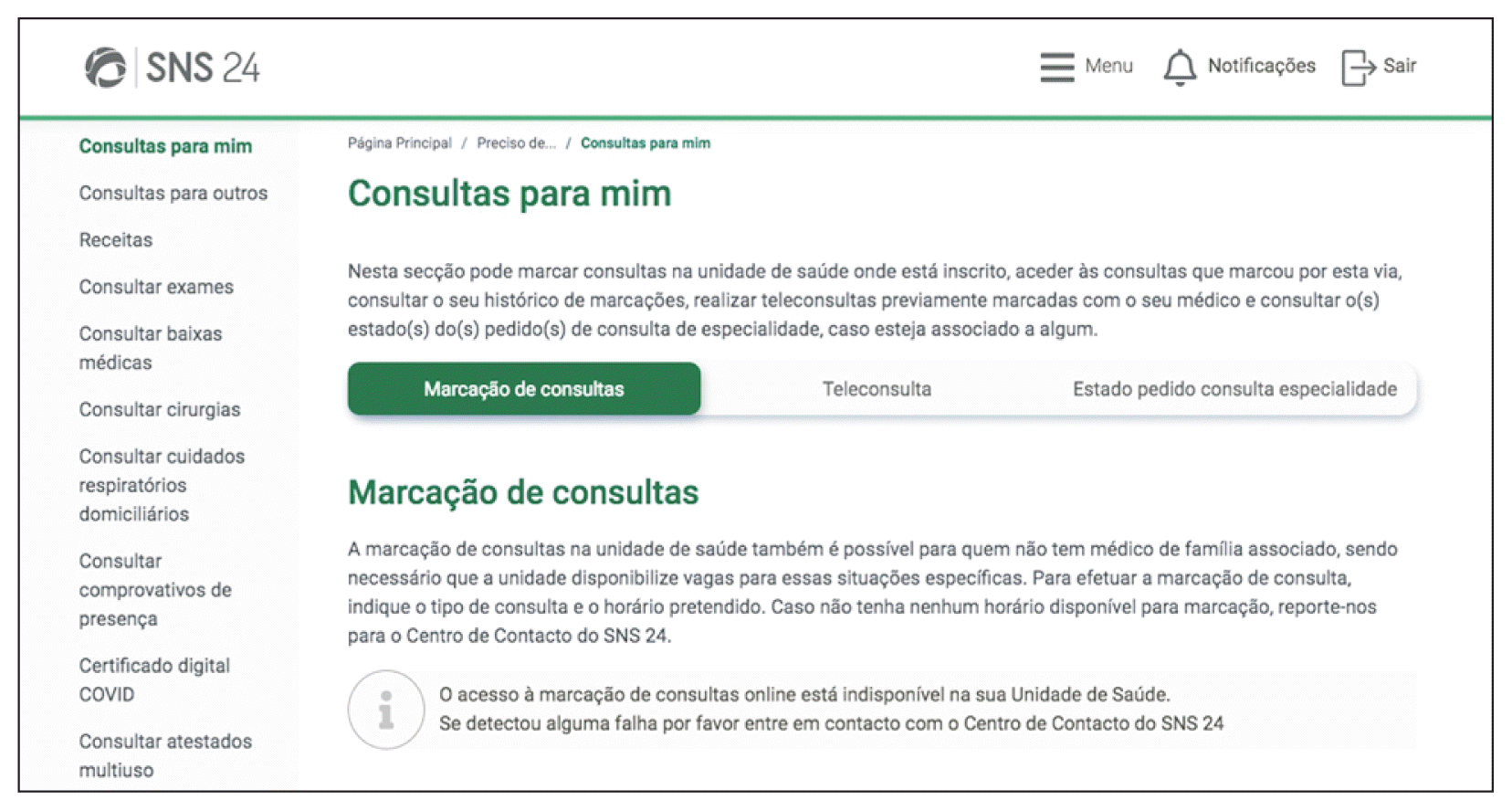 | Figure 1Screenshot of the Portuguese portal for online consultation booking. The message in the gray box at the bottom reads: “Access to online consultation bookings is unavailable at your health unit.” 
|
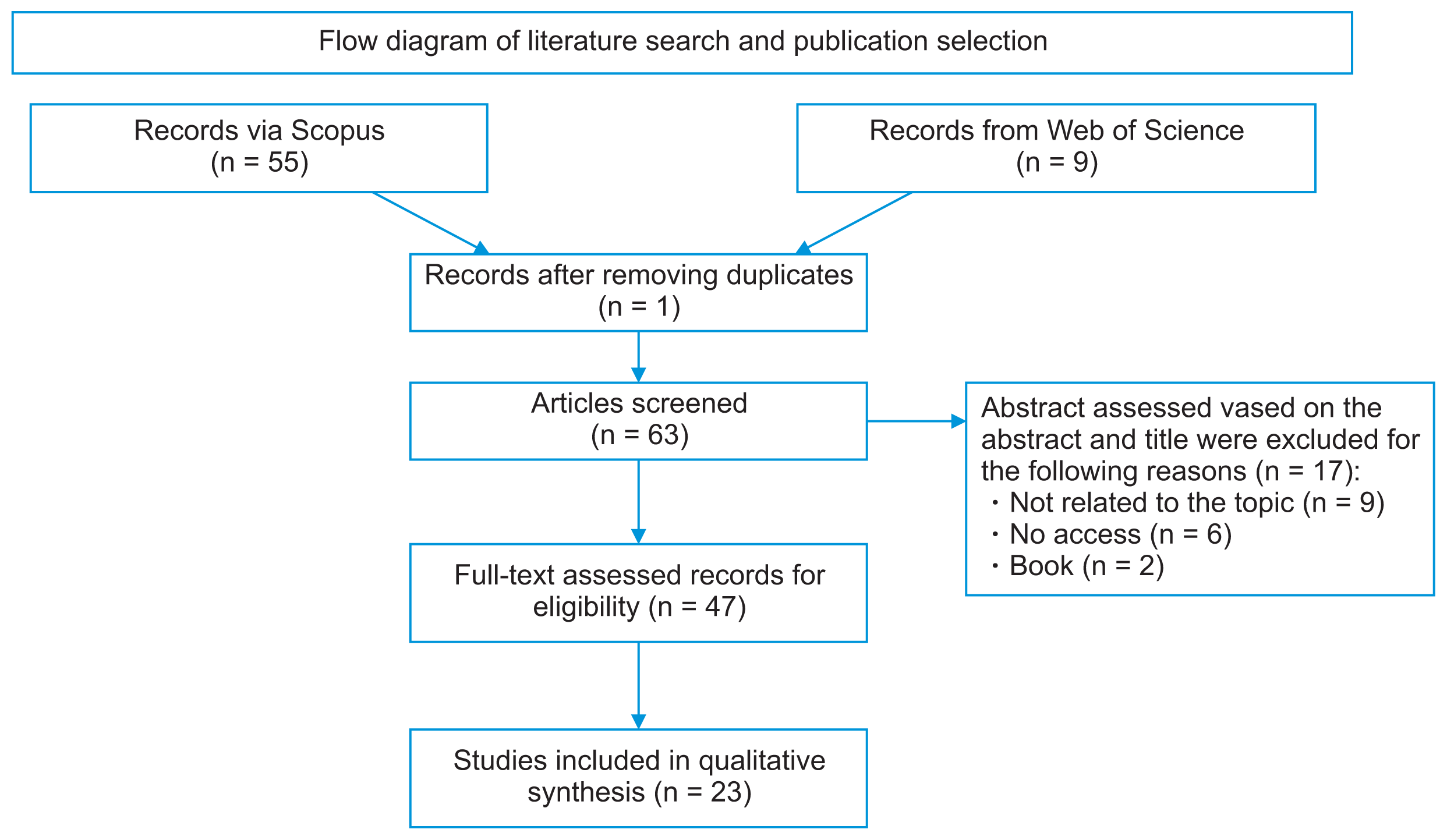 | Figure 2Flow diagram of literature search and publication selection. 
|
Hospital consultations can be initiated by a user’s family doctor through an online platform named “Consultations On Time.” This system simply forwards the consultation request along with a brief clinical summary to the appropriate hospital department. Upon receiving the request, a hospital doctor conducts a preliminary screening, after which the department’s secretariat schedules the appointment. Additionally, consultations may be requested by other hospital specialists using internal computer systems; however, these requests are always processed either by the secretariat or by a specialist doctor. It is important to note that patients are not allowed to directly approach a medical service to request a hospital consultation without a prior referral from another doctor, whether submitted online or in paper form.
To address these issues, the government has introduced the pilot project “Call First, Save Lives,” which was previously mentioned. This initiative enables users to secure an appointment with their family doctor or another physician at a specific date and time, rather than merely requesting an appointment. Appointments can be arranged by calling the hotline emergency telephone service, thereby preventing unnecessary trips to the hospital emergency room (
Figure 3).
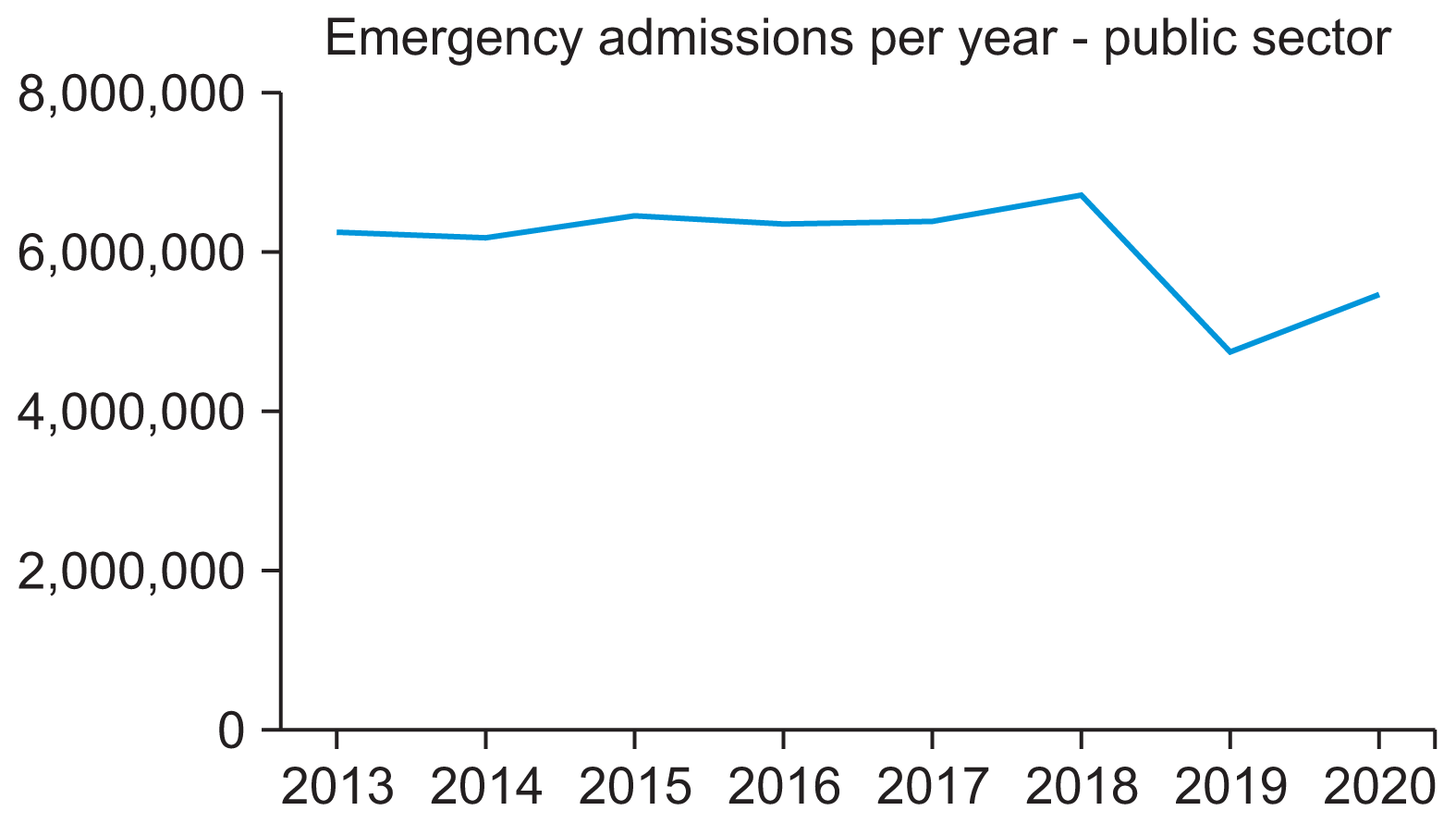 | Figure 3Total number of emergency room visits in the Portuguese SNS (National Health Service) [ 5] from 2013 to 2020. 
|
Given this new solution, it is crucial to examine the recent history of online consultation booking systems and learn from the experiences of other public health services. Understanding the main challenges, obstacles, and problems that may arise is essential. As will be discussed in the following sections, numerous health systems worldwide are attempting to leverage the technical capabilities of the internet and electronic devices to simplify communication with patients. However, unexpected consequences can occur, depending on the observed variables.
Go to :

Methods
The methods used in the present work were based on the Preferred Reporting Items for Systematic Reviews and Meta-analyses (PRISMA-ScR) [
6]. Searches were conducted in two databases, Scopus and Web of Science. To explore this issue, articles published in the last 5 years were searched using the keywords “online scheduling,” “online booking,” and “consultations.” For the articles to be eligible, they had to be in English, peer-reviewed, and available online.
The search was conducted in the last week of December 2023.
The inclusion criteria for the article screening process were as follows: (1) studies focusing on the use of medical informatics to schedule consultations; (2) articles addressing health information technology or medical informatics interventions designed to enhance health access; (3) randomized clinical trials, quasi-experimental studies, observational studies, reviews, and meta-analyses; (4) articles published after 2018; (5) studies conducted in English; and (6) articles published in journals indexed with a peer-review system.
The exclusion criteria included: (1) articles with titles, abstracts, or full texts unrelated to online consultation scheduling; (2) theses, book chapters, letters to editors, editorials, short briefs, case studies, conference papers, and study protocols; and (3) studies for which the full text was unavailable.
From Scopus, 55 articles were obtained, and from Web of Science, 9. After reviewing the titles and abstracts, and checking for access and duplicates, 23 articles were retained as original and relevant to this work. The author of this study conducted the entire process.
Go to :

Discussion
Based on the 23 articles selected, the key factors to consider when contemplating the use of online scheduling for health purposes—ranging from its advantages to the primary risks involved—are reviewed. It is important to recognize from the outset that technology cannot compensate for deficiencies in the actual provision of healthcare. In other words, if doctors, nurses, and other health professionals lack the capacity to deliver care, technology alone cannot rectify this shortfall [
7]. However, technology can facilitate communication among various stakeholders in health services.
This review included only articles published in academic journals post-2018, written in English, and indexed in Scopus and Web of Science. As such, it did not incorporate the findings from all articles on the subject. Additionally, not all existing online consultation booking systems were examined, and certain studies focus exclusively on the private sector.
First, the communication between Portuguese hospitals and health centers, specifically between general and family medicine and hospital specialties, was never fully established, except under specific circumstances that typically relied on the proactive efforts of doctors and nurses through meetings or localized projects [
30]. One of the most recent initiatives designed to address this issue was introduced in Vila do Conde and Póvoa de Varzim [
4].
In navigating the complex relationship between users and health services, it is crucial to differentiate between two scenarios: scheduling a follow-up consultation for a patient already under observation for a condition, such as a chronic illness, and arranging a first-time consultation in any specialty following a referral from a healthcare professional. In the latter scenario, the referral ensures that the patient has medical support for accessing healthcare services. Alternatively, a user might independently seek a consultation without any prior referral. This option raises the most questions within health services, yet it appears to be the most popular among users. Specifically, they value the ability to consult a specialist directly whenever they feel the need, as is the case in the private sector.
The various methods for scheduling a consultation are depicted through three distinct models, corresponding to the hospital (
Figure 4), the health center (
Figure 5), and the ongoing pilot project (
Figure 6).
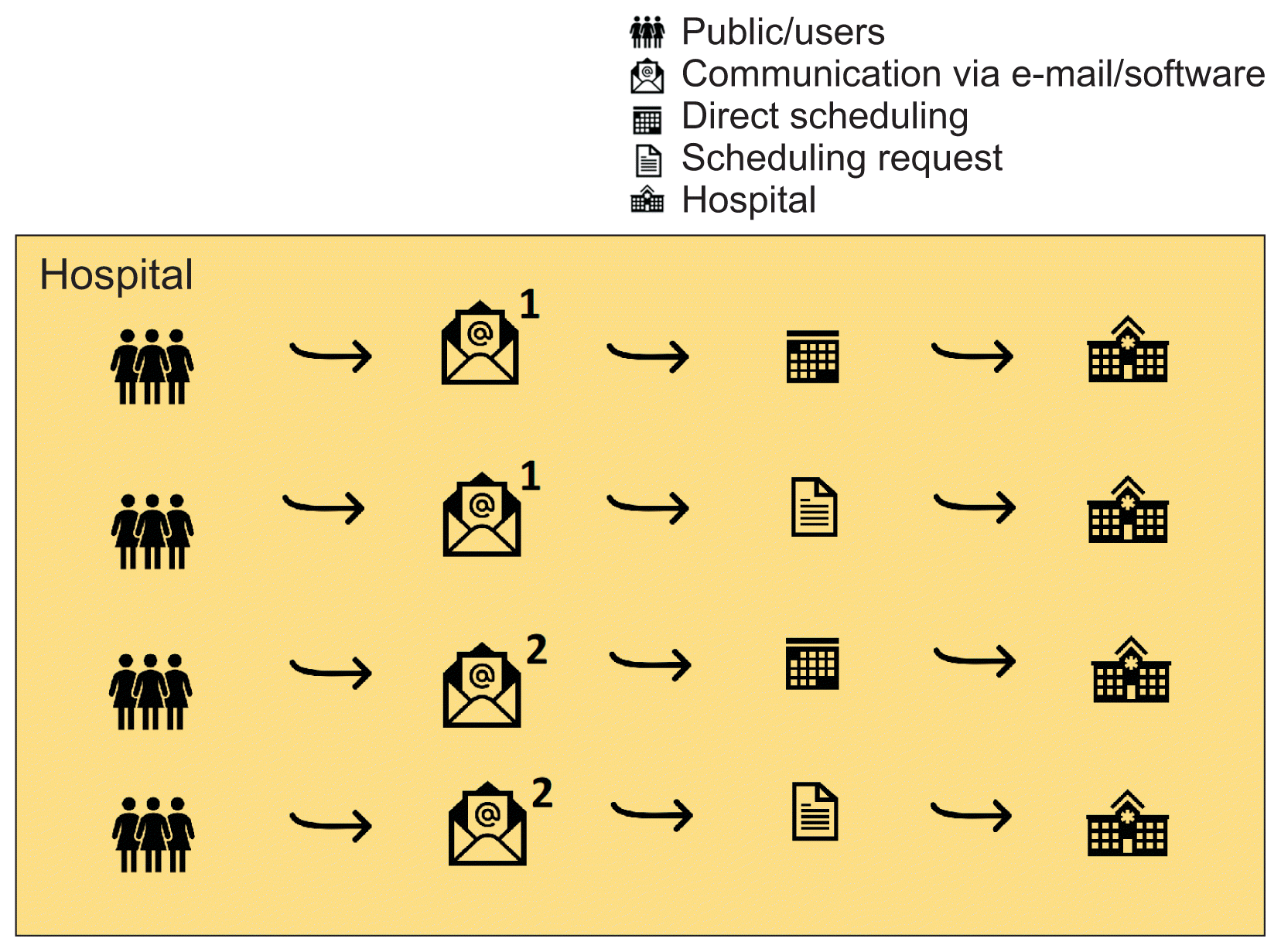 | Figure 4Different possibilities for making an appointment at the hospital, either a first “1” consultation or a follow-up “2”, through a direct appointment or a delivery of an order at a hospital. 
|
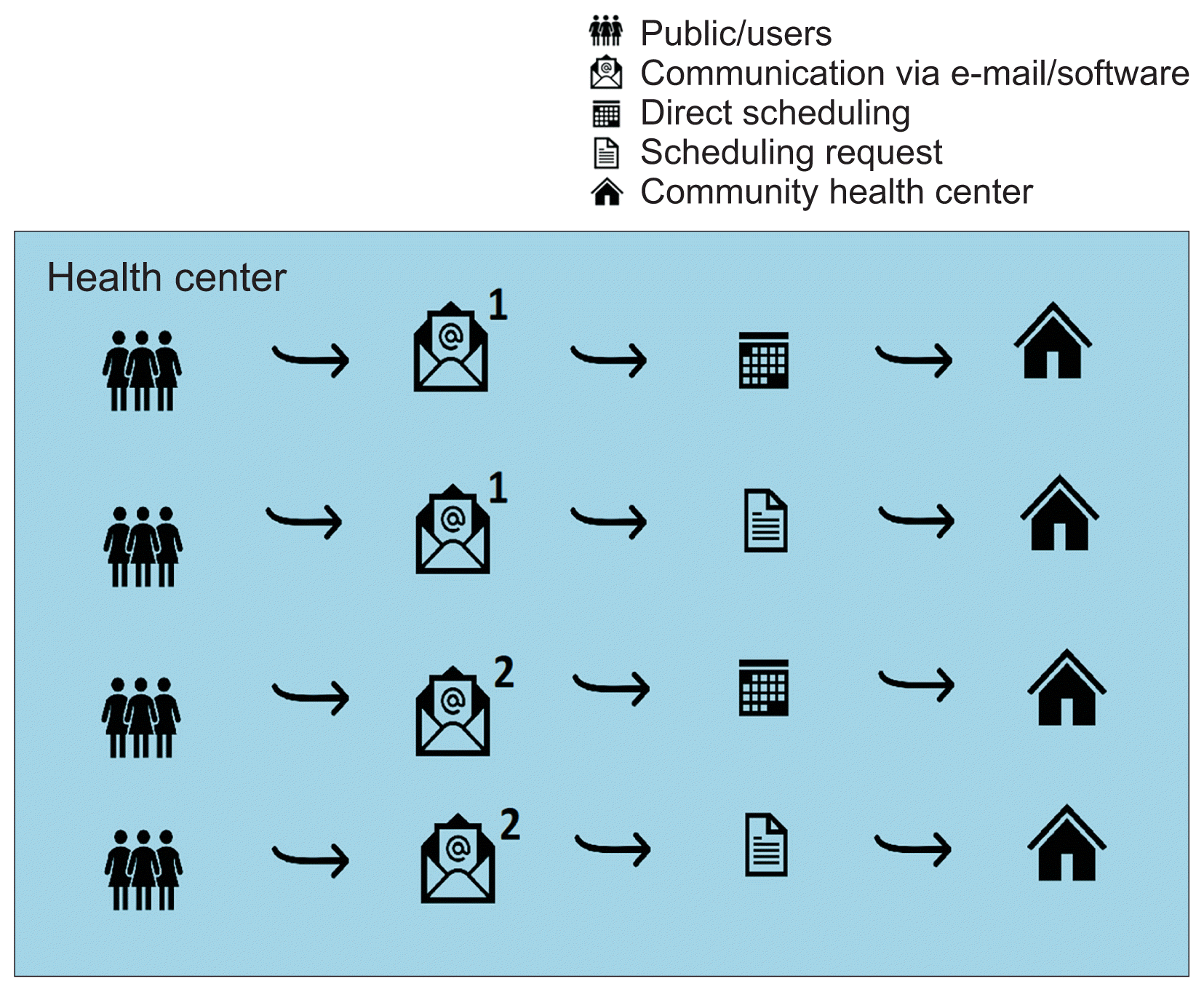 | Figure 5Different possibilities for making an appointment at a health center, either a first “1” consultation or a follow-up “2”, through a direct appointment or a delivery of an order at a health center. 
|
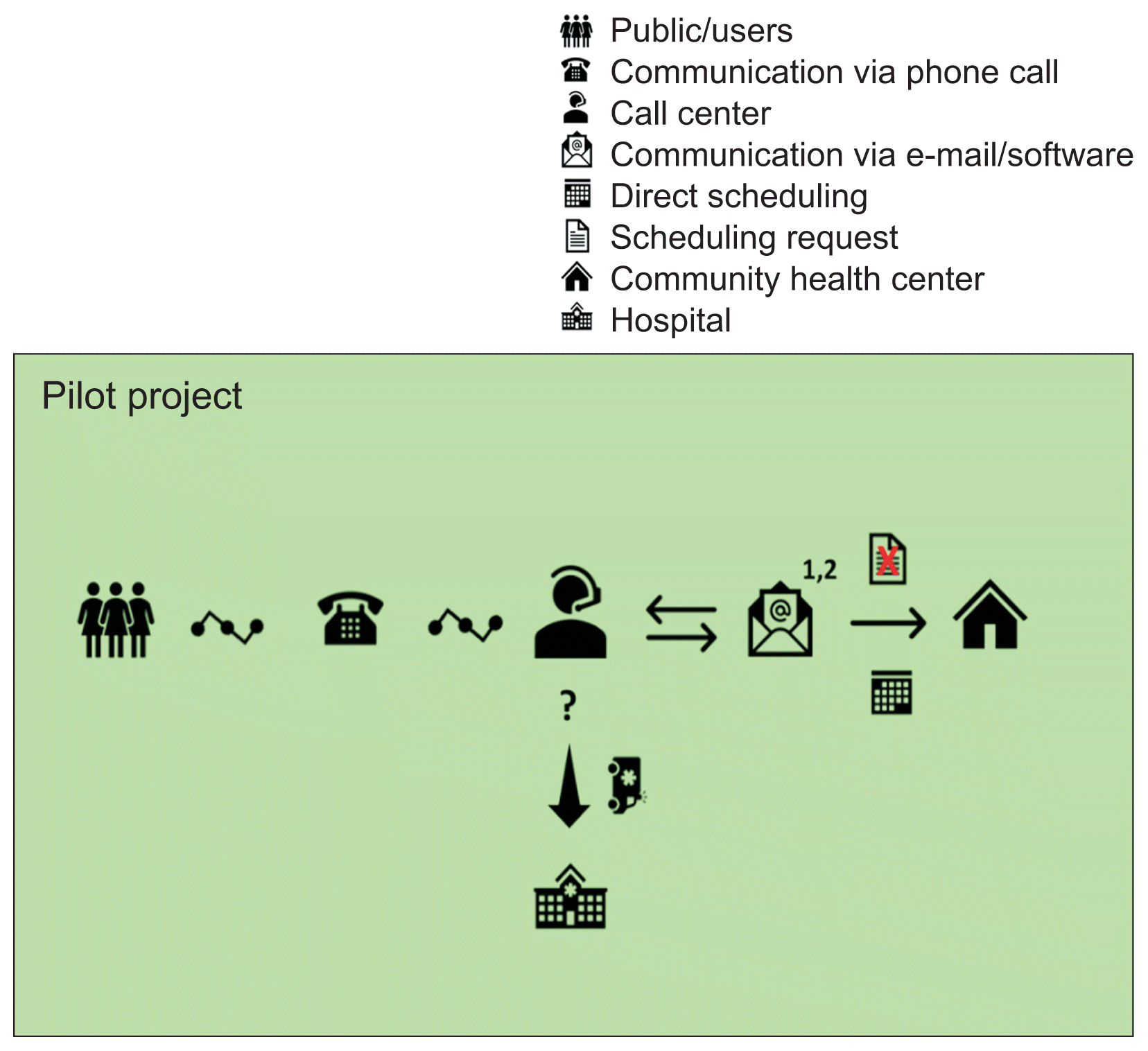 | Figure 6Pilot project of Póvoa de Varzim, Portugal. Users will be able to contact a call center (SNS24) in which a trained technician will carry out a triage. Users who are not referred to the hospital emergency room will have an appointment scheduled directly at their health center. 
|
The articles reviewed identify several limitations of the online consultation booking system, whether deferred or in real-time. When appointments are made by a person, such as an employee or a doctor, there is flexibility to make minor adjustments based on the specific needs of each patient and the available schedules. In contrast, an online system is inflexible and unable to accommodate these nuances [
14]. Additionally, each doctor often has unique scheduling preferences that an online system cannot easily adapt to, although there are exceptions [
31]. Such systems also result in a loss of customization concerning appointment times, which could prevent doctors from prioritizing consultations based on the severity of cases or from rearranging breaks during their workday [
14]. Concerns about safety have also been raised. Patients might schedule appointments without being able to accurately judge the urgency of their health needs, potentially leading to serious conditions being inadequately addressed in outpatient settings. This issue largely depends on the presence of an effective triage system, which is itself complex and has been the subject of research [
32]. Some researchers have warned of “unexpected effects” when implementing electronic scheduling systems [
10]. A study from China indicated that an increasing number of patients were scheduling appointments before consulting a doctor. However, these systems have pitfalls, as the timing of appointments may not align with the clinical urgency of patients’ conditions. Consequently, those who are first in line may not necessarily be those who most urgently need care [
32]. Another study suggested that for multistep treatment plans, such as oncological protocols, sequencing appointments could yield better outcomes than current scheduling practices [
11].
Concerns have been raised about overbooking, as users might schedule too many appointments when time slots open—either from fear of missing out or due to hypochondriac tendencies—and then fail to show up or cancel at the last minute. The availability of free consultation slots could lead users to perceive certain doctors as less busy or in less demand. Additionally, there are potential limitations related to the cost, flexibility, security, and consistency of online booking systems [
14]. Moreover, potential obstacles from the users’ perspective include difficulties in using the internet, distrust of electronic systems, a preference for speaking directly with someone, or simply being unaware of the availability of online appointments [
14]. Age has also been identified as a significant factor, distinguishing those who are more adept at using technology, typically younger individuals [
12,
33], from older individuals. Despite these issues, the diversity of communication methods, both online and offline, can enhance interactions between citizens and health services [
13]. It has also been observed that self-scheduling leads to a higher cancelation rate [
12]. Other sources of inequality may emerge when access is mediated electronically. Some studies have found that women are more likely to use online services, while being non-white, economically disadvantaged, or having health vulnerabilities can hinder access to e-health services [
30].
An interesting study on online consultation booking was recently published in Taiwan [
12]. The authors highlight that Taiwanese society boasts a high internet penetration rate— 80% in 2017—and is recognized as a global leader in technology. Despite this, the ability to access hospital services online is hindered by a rural-urban divide, with significantly lower percentages of online hospital access reported in rural areas [
33]. This issue has also been noted in other studies [
30]. It is generally more challenging to book an initial consultation than a clinical follow-up, as hospital services with online booking systems typically permit rescheduling but do not allow for the booking of first-time appointments. The study also explored how far in advance patients could schedule a first consultation. The findings revealed that the maximum lead time was approximately 90 days, while the minimum was only 7 days at local clinics. In regional or central hospitals, this minimum scheduling time extended to 14 days, indicating a faster response rate in the system’s more peripheral or less centralized services, depending on one’s perspective. Interestingly, when booking a first consultation, users are not required to provide a reason for the appointment.
Some authors have noted that online consultation booking might exclude older individuals or those who do not frequently communicate via email [
31,
33]. This exclusion largely depends on the level of internet penetration within the specific population group.
Concerning rural areas, one study demonstrated how an algorithm can enhance the scheduling system and improve access to quality health services in rural China [
17]. In Nigeria, which is not yet a developed country, there exists an intelligent electronic appointment system that incorporates the clinician’s role in authorizing each appointment. This system allows patients to schedule appointments from their homes, thereby reducing the potential spread of infectious diseases [
18].
Due to changes in consultation demand triggered by the coronavirus disease 2019 (COVID-19) pandemic, questions have emerged regarding the actual reduction in waiting times for online consultations during this period [
21]. It is noteworthy that access to electronic health booking systems proved more effective among those who are economically and educationally privileged, as some authors have observed [
20]. This was also true for individuals with chronic illnesses, which raises concerns about the universality of healthcare access. Additionally, physicians expressed uncertainty about choosing between face-to-face and online consultations, lamenting the loss of direct patient contact. This has underscored the necessity to develop clinical decision-making protocols to determine the most appropriate means of communication [
22]. These observations suggest that COVID-19 may have been a pivotal moment for the adoption of electronic methods in medicine [
19,
20].
As regards privacy, we can categorize concerns into two main types. One the one hand, there are technical questions, which involve ensuring that information is safe and encrypted [
23]. This concern is not unique to healthcare, and has been raised in other industries as well [
24]. On the other hand, there is the issue of anonymity: online appointment scheduling can enhance anonymity, particularly in specialties associated with greater social stigma, such as psychiatry or sexually transmitted diseases. This increased anonymity can improve access for more stigmatized groups [
30]. Mold’s study also explored the potential for users to abandon direct booking if available dates are not frequently updated, which could undermine their trust in the system. Furthermore, online access provides users with information about the schedules and activities of medical staff, potentially creating the impression that more resources are available than the ones that actually exist. This discrepancy poses a challenge for the management and reputation of hospital services.
According to some authors, providing patients with access to their health information can strengthen their sense of control, empower them, and transform the doctor-patient relationship [
30]. However, there are concerns about the potential health consequences of allowing patients indiscriminate access to this information [
30]. It is also important to differentiate between online scheduling and self-scheduling. The latter not only utilizes electronic means but also grants patients the direct authority to schedule their appointments. This has been identified as a complex intervention that warrants further investigation—on the one hand, it enhances patient satisfaction, but on the other, it may lead to an increase in the no-show rate [
8,
25]. The no-show rate is a significant variable in web-based appointments [
26]. Some studies suggest that online appointments may increase both the no-show rate and patient tardiness [
27], while others indicate that the cancelation policy affects attendance rates [
33].
While the ability to communicate with health services is crucial for ensuring their efficiency, these services can only function properly when they are endowed with sufficient human, financial, and logistical resources. Here, it is important to consider (although it is not the primary focus of this article) public investment in healthcare, from human resources to the operational means available, as without this investment, the demand will not be met [
7].
New technologies are continually emerging, and artificial intelligence is expected to drive significant advancements in this field. An example of this is the recent development of a “decision support system”. This system customizes scheduling decisions based on individual patient behavior profiles, thereby minimizing waiting times and reducing additional work at the end of each session [
34].
Overall, online engagement with health services is viewed positively; however, it does have its limitations and carries the risk of exacerbating inequalities in healthcare access.
The lack of an international nomenclature for online booking systems hinders more comprehensive and thorough research [
30]. It is important to note that this article is a scoping review, which entails significant limitations. Notably, some relevant studies may have been overlooked, and the sheer volume of publications in this field may have limited the accuracy of the selection process. Additionally, it should be mentioned that the review process was conducted by a single researcher, potentially limiting the objectivity of the decisions made.
It is hoped that by establishing a connection between the research published in this field since 2018 and a specific ongoing experiment in Portugal, other researchers and policy actors will be encouraged to think critically about healthcare access.
In conclusion, finally, although the internet is a nearly universal reality, it presents a vast array of solutions that make analyzing different consultation booking systems a complex task. Indeed, numerous variables and micro-variables, such as the type of healthcare involved [
29], can cause two seemingly similar systems to differ significantly. The diverse capabilities of technological systems introduce significant concerns regarding access, confidentiality, and security, which require detailed examination. Although internet-based communication with health services appears to enhance access, it may actually exacerbate disparities between urban and rural areas and further marginalize economically vulnerable populations and the elderly. Addressing these issues is vital for future research.
In our opinion, it is crucial to expand this research and explore the potential impacts and challenges associated with the application of artificial intelligence to various medical procedures, including consultations and examinations. In the realm of online medicine, the pace of research is noticeably slower than the rate of technological progress.
Considering the complexities of online scheduling, policy actors interested in this field should advise all relevant authorities to invest in research on technologies and healthcare access. This is very important, as any misguided decision can have systemic consequences.
Go to :







 PDF
PDF Citation
Citation Print
Print







 XML Download
XML Download